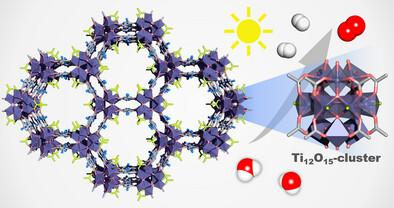
Check out the latest paper from IMAP and colleagues here:
https://advanced.onlinelibrary.wiley.com/share/6ZQXKUNPZRHRNQ3JHRS2?target=10.1002/aenm.202500211
A new microporous titanium-based metal-organic framework (Ti-MOF), labeled as MIP-209(Ti) (MIP: Materials from Institute of Porous Materials of Paris), features nitro terephthalate ligands and Ti12O15 oxo-clusters, as revealed by continuous rotation electron diffraction (cRED). MIP-209(Ti) can be obtained using two different terephthalate (1, 4-BDC2−) derivatives such as NO2-BDC and 2Cl-BDC in an eco-friendly solvent, suggesting the isostructural versatility of Ti12-MOFs. Alternatively, its Ti-oxo-cluster can be tuned, similarly to MIP-177(Ti)-LT bearing the same Ti12O15 sub-unit. Typically, low percentage Cr3+ doping (≤5 at%) in MIP-209(Ti) favorably enhances the water stability. MIP-209(Ti-Cr)-NO2 shows a significant hydrogen production rate, with good reusability and stability under simulated solar light irradiation. Compared to the benchmark Ti-MOF IEF-11, the hydrogen production of MIP-209(Ti-Cr)-NO2 with 5 at% Cr doping has a fourfold enhancement in photocatalytic hydrogen evolution from water splitting reaction (HER) during 5 h in presence of methanol (5 812 µmol/gcat against 1 391 µmol/gcat), as well as, without any noble metal co-catalyst, a sixfold enhancement in overall water splitting reaction (OWS) (681 and 325 µmol/gcat of H2 and O2, respectively, against 94 and 53 µmol/gcat of H2 and O2, respectively). This work represents a leap forward in the synthesis of Ti-MOFs and their practical photocatalytic applications.

